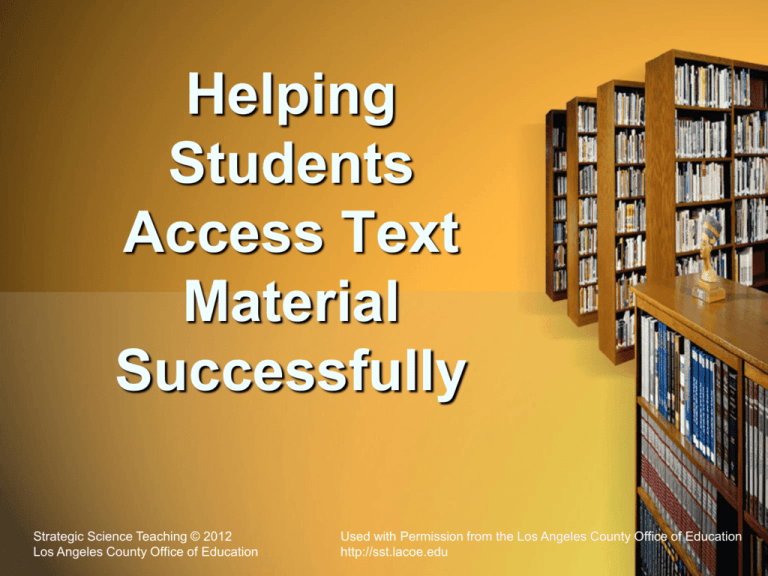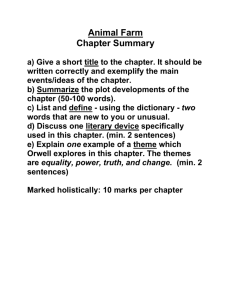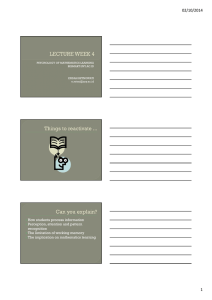
Helping
Students
Access Text
Material
Successfully
Strategic Science Teaching © 2012
Los Angeles County Office of Education
Used with Permission from the Los Angeles County Office of Education
http://sst.lacoe.edu
Some Reflective Thoughts
• “I can explain it to you, but I
can’t understand it for you”
Anonymous
• "I cannot teach anybody
anything, I can only make
them think."
Socrates
Schemata: Have You Got It?
1. People “construct” meaning in their life
based on their store of memories:
everything they have ever
1. sensed
2. experienced
3. learned
Schemata: Have You Got It?
1. Schema = HOW people organize and store
information in their heads. It reflects
1. experiences
2. attitudes
3. values
4. conceptual
understanding
5. skills & strategies
that readers bring to a text
situation
Schemata: Have You Got It?
1. Schema provides mental
shortcuts to help us absorb
the bombardment of stimuli
from a complex world.
Schemata: How it Functions
Schema functions in 3 ways:
1. Gives a framework to understand
reading and fill in gaps
2. Helps readers organize text
information and REMEMBER
what’s been read
3. Helps readers elaborate
information involving deeper
levels of insight, memory
judgement and evaluation.
Schemata: Have You Got It?
1. Read the passage and fill in the
blanks with words that make
sense to you.
2. Answer the questions using
sentences.
3. Get in pairs and read passages
to each other.
4. Find out if any groups have the
exact same wording.
5. Share your responses in pairs.
6. Have a class discussion on what
strategies students have when
dealing with a science text.
Read & Fill in Missing Words
The questions that p ________ face as they
raise c______ from in________ to adult life
are not easy to a_____. Both f______, and
m________ can become concerned when
health problems such as co________ arise
any time after the e__ stage to later life.
Experts recommend that young c_______
should have plenty of s ______ and nutritious
food for healthy growth. B______ and g____
should not share the same b ______ or even
sleep in the same r____. They may be afraid
of the dark. Adapted from Madeline Hunter
Read & Fill in Missing Words
The questions that poultrymen face as they
raise chickens from incubation to adult life
are not easy to answer. Both farmers, and
merchants can become concerned when
health problems such as coccidiosis arise
any time after the egg stage to later life.
Experts recommend that young chickens
should have plenty of sunshine and nutritious
food for healthy growth. Banties and geese
should not share the same barnyard or even
sleep in the same roost. They may be afraid
of the dark. Adapted from Madeline Hunter
Reflecting on Schemata
Answer in complete sentences
and get ready to share your work
1. How did you decide what the passage
was about?
2. Did the passage make sense to you?
3. Do you think there may be an
alternative way to fill in the blanks?
4. Listen carefully to the original passage.
5. What are your thoughts and reactions?
6. When reading your book, what
problems do you have with the text?
7. Do you use any reading strategies that
help you understand the text? What are
they?
Thinking Processes Used
By Good Readers
Having A Conversation with Yourself
Why am I reading this? To understand & remember
What am I reading?
A science text or article
I'd better use some specific strategies to attack
this material: it's complicated!
• An important part of the college
experience is learning to learn.
• SQ4R is one strategy that can help you get
the most out of your textbook reading.
• SQ4R will assure that you don't just "do
it," when it comes to your reading
assignments:
– you will derive as much as you possibly
can out of the experience.
• Overview: quickly look for the main
idea or unifying theme
– Table of Contents
– Introduction/Summary; first
sentence of each paragraph
– Headings (memorize if
possible)
– Pictures, charts, diagrams, etc.
– Vocabulary lists, notated print,
captions, etc.
As You Are Surveying:
Have a conversation with yourself:
• How is the text organized?
• What do I know about the topic
already?
• What do I expect it to talk about?
• Do I need to use some kind of
graphic organizer like a concept
map?
• Establish a purpose. Begin to think
about the material.
– Turn headings and
subheadings into
questions.
– Read all questions within
the chapter/text.
– Try to guess at the
answers.
What About Unknown Words?
• I can use context
clues to figure out
what words probably mean.
• I can look for familiar word
parts if it doesn't slow me down
• I can look it up now if it seems to
be important to understand the
rest.
• I can ask someone what it means.
• I can write it down and look it up
later
• to answer questions
– Carefully read (in
manageable chunks) to
answer questions.
– Correct incorrect guesses
from early questioning.
– Note important details,
relationships
Questions to ask myself when I don't
understand what I've read
1. What are the unknown
vocabulary words? Can I
figure out what they mean?
2. Are there sentences that
don't make any sense?
3. Are there concepts that are
unfamiliar?
Questions to ask myself when I don't
understand what I've read
4. Is the writing hard to
follow? Are the sentences too
long? Do they jump around?
5. Am I getting lost in details
and missing the big picture?
6. Am I confused because the
parts don't seem connected?
• Answers to questions with the book
closed
– State orally answers to
questions.
– State key facts and
concepts.
– Reread any areas which
are unclear.
• Take notes!
– Take accurate notes on
basic concepts.
– Create a graphic
organizer
– Prepare a study sheet for
exams.
– Use outline or Cornell
Note format
• at short intervals
– Review notes.
– Be able to answer all
questions.
– Predict test questions and
answer them.
REVIEW
Have a conversation with yourself:
• Does my graphic
organizer make sense?
• Have I missed any important
ideas or vocabulary?
• Can I paraphrase the main
ideas from memory?
• Can I apply the info to a new
situation?
Model & Encourage Reading the Text
• Model the SQ4R method of reading a text.
– Question aloud, show your own notes as
overheads
• Assign a chapter to read on their
own
• Take Cornell notes on the
chapter
• Grade the questions they
generate OR
• Let them use their notes on a
quiz
KWL
KNOW
WANT
What do I
What do I WANT
already KNOW
to learn about
about the topic?
the topic?
LEARNED
What did I
LEARN about
the topic?
Reading In Science
3 Reading Activities
1.Scanning Races
1. Improving speed &
comprehension
2.Make Golden Sentences:
1. Learning to paraphrase
3.Anticipatory guide:
1. Creating Higher-level
Questions
2. Using Cornell notes backwards
Scanning Races
1.Using a teacher-generated question sheet,
READ a short but intensive article as
quickly as possible, filling in answers.
1. Raise your hand and shout
“DONE” when finished with
all questions
2. Be prepared to share
out to the group!
Golden Sentences
1. Individually read an in-depth
article
2. Distill the entire article down
to one to two key sentences.
1. Use the sentences to
make a poem
3. Be prepared to
share out to
the group!
Anticipatory Guide
“Backward” Cornell Notes:
1.While reading a rigorous
article, use a teachergenerated sheet of questions
to create Cornell notes
2.Using the questions as
reading guide, continue until
you have finished the article
& filled in the notes.
Significant Statements
1. Individually
1. Write 3 significant statements
about a chapter in the text.
2. Remember to
paraphrase,
not plagerize
2. In a small group
1. Write 3 GROUP significant
statements after sharing
individual ones
Significant Statements
3. In a small group
1.Create a poster illustrating
your 3 group statements.
2.Include pictures, examples,
diagrams
4. Get ready to share
your work!
Developed by
Anne F. Maben
AVID LACOE Science Coach
Leslie Hays
AVID SDCOE AP Coordinator
© 2002 LACOE
All rights reserved









